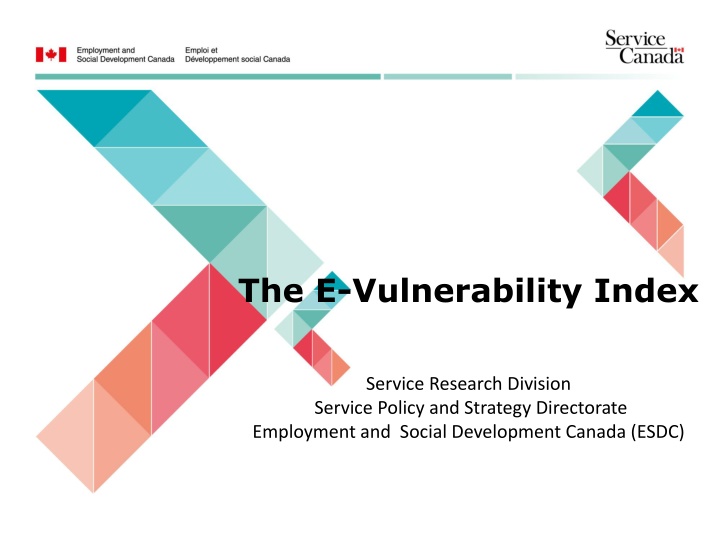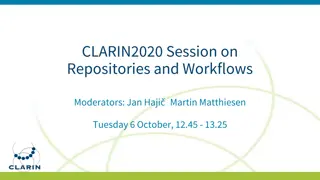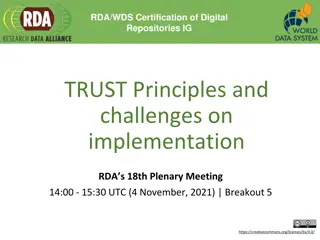
E-Vulnerability Index for Service Canada Centers
Discover the E-Vulnerability Index (EVI) developed by ESDC to assess the digital service disadvantage faced by individuals accessing online government services. The EVI measures Internet access, comfortability, and competencies to ensure inclusivity and support for e-vulnerable populations. Learn how this index informs Service Canada's strategies for service delivery and transformation.
Download Presentation

Please find below an Image/Link to download the presentation.
The content on the website is provided AS IS for your information and personal use only. It may not be sold, licensed, or shared on other websites without obtaining consent from the author. If you encounter any issues during the download, it is possible that the publisher has removed the file from their server.
You are allowed to download the files provided on this website for personal or commercial use, subject to the condition that they are used lawfully. All files are the property of their respective owners.
The content on the website is provided AS IS for your information and personal use only. It may not be sold, licensed, or shared on other websites without obtaining consent from the author.
E N D
Presentation Transcript
The E-Vulnerability Index Service Research Division Service Policy and Strategy Directorate Employment and Social Development Canada (ESDC)
Table Of Contents Background Creation of the Index of E-Vulnerability (EVI) - Challenges and Data sources - Methodology - How to read the index? Analytical Results - EVI scores at the national level - EVI scores by different segments of the population across Canada - EVI by Service Canada Center Does the E-vulnerability Index vary by Service Canada Center? Service Canada Center Examples 2
Background With the increase in Internet-related technologies and Internet use, the Government of Canada is offering more and more services online. This shift is reinforced by the 2014 Treasury Board of Canada Policy on Service which establishes the principle that Government of Canada s services should be designed and delivered by considering client needs and feedback, and should be progressively e-enabled, not only to provide a better client service experience but also for efficiency purposes. Accordingly, many services (e.g. the Employment Insurance application process) are now being provided online by Service Canada and a great number of Canadians are benefiting from the resulting efficiency. 3
Background (contd) However, some segments of the population are likely to experience financial, attitudinal and/or skill-based barriers when using government s online services. These so-called e-vulnerable individuals will need different kinds of support to answer their needs. In light of this, Service Canada remains committed to providing an in-person option for service delivery throughout Canada (known as the in-person point-of- service footprint ). Totally, more than 500 Service Canada Centres (SCCs) across Canada provide a wide range of government programs and services to Canadians, including Employment Insurance, Canada Pension Plan, Old Age Security, Passport, etc.. It is important, therefore, that Service Canada has access to measures of e-vulnerability to inform its Service Delivery and Service Transformation Strategies. 4
Background (contd) SOLUTION: To answer the need of information on e-vulnerable population segments, Service Research Division within ESDC has developed an index of e-vulnerability (EVI) for each of the Service Canada Center (SCC). DEFINITION: The EVI measures the extent to which some individuals will be at a service disadvantage with the digitization of services. The index measures three dimensions of cyber vulnerability: Internet Access:The access dimension measures whether or not individuals have the means (financial, material) to benefit from available technologies. Comfortability: The comfortability dimension relates to the willingness or desire of individuals to use technologies. Competencies: The skills/competencies dimension captures whether or not individuals have the necessary abilities and knowledge to take advantage of the technologies. ADVANTAGE: This information will enable the Government of Canada to identify Service Canada Centres that are servicing more e-vulnerable Canadians. 5
Background (contd) This measure of e-vulnerability refers to the concept of digital divide . The concept of digital divide has been conceived by Husing and Selhofer (2002) as the gap between citizens from different socio-economic backgrounds with regard to their opportunities and abilities to access and use information and communication technologies . There has been significant research dedicated to understanding the digital divide and identifying ways to effectively measure it (Barzillai-Nahon, 2006). 6
Creation Of The Index Of E-Vulnerability Challenges and Data sources Data pertaining to the Internet readiness of the overall Canadian population is primarily collected through the following surveys: Canadian Internet Use Survey Last conducted in 2012 by Statistics Canada, new data in 2018; Observations collected from 22,615 individuals aged 16 and older; The CIUS includes a set of questions identifying increasingly advanced tasks that individuals can perform using the Internet, from sending and receiving email to selling goods and services online; Questions in the CIUS are related to Internet Access and Comfortability . Programme for the International Assessment of Adult Competencies Last conducted in 2012 by Statistics Canada; Observations collected from 25,267 individuals aged 16 to 65; The PIAAC assesses not only respondent s computer literacy, but also the ability to solve problems in a technology-rich environment (PS-TRE); Questions in the PIAAC are related to Internet Competencies . CIUS PIAAC 7
Creation Of The Index Of E-Vulnerability Challenges and Data sources Neither of those two surveys has enough sample size to generate reliable information at the Service Canada Centre level. To address this issue, our solution was to recreate those three dimensions of e-vulnerability (Access, Comfort and Competencies) for each respondent in the National Household Survey (NHS). NHS The 2011 NHS covered 4.5 million dwellings and 6.7 million Canadians. Though the NHS collects a wide array of demographic and socio- economic information, it does not include any questions relating to Internet use or skills. 8
Creation Of The Index Of E-Vulnerability Methodology * *PS-TRE: problem solving in technology-rich environments EVI and sub-index were created using factor analysis Each sub-index is a weighted score of a number of indicators The EVI is a weighted score of the sub-indices Models account for observed regional variations (Small Area estimation techniques) 9
Creation Of The Index of E-Vulnerability How to read the index? Results: Each individual in the NHS (16 and +) was assigned a specific EVI score ranging between 0 and 1 0: Individual is at very low risk of being e-vulnerable 1: Individual is at very high risk of being e-vulnerable An e-vulnerability score is first determined at the individual level and since the NHS contains the postal code of the each respondent, the index can be aggregated to the geographic level of our choice (census metropolitan area (CMA), census subdivision (CSD), Service Canada Centers point of services) 10
Analytical Results EVI scores at the national level The average individual EVI score nationwide is 0.38. The average individual scores for the: Access dimension is 0.29 Comfort dimension is 0.41 Skills dimension is 0.61 EVI Scores for the Top CMAs Top CMA Population EVI Score Access Sub- Comfort Competencies Living in the Index Score Sub-Index Score Sub-Index CMA Score Toronto 4,473,165 0.35 0.25 0.37 0.60 Montr al 3,072,610 0.38 0.30 0.40 0.63 Vancouver 1,897,675 0.34 0.24 0.38 0.58 Ottawa-Gatineau 989,105 0.32 0.24 0.35 0.52 Calgary 961,120 0.29 0.19 0.33 0.50 Edmonton 921,090 0.33 0.24 0.36 0.59 Qu bec 626,010 0.38 0.31 0.39 0.62 11
Analytical Results EVI scores by different segments of the population across Canada EVI Scores for Different Segments of the Population A national E-Vulnerability Index (EVI) could help service delivery organizations support the shift to digital services by helping to mitigate unintended consequences on e- vulnerable groups. 1.0 0.8 E-vulnerability Increases 0.6 0.4 The index was customized for the different subgroups: Immigrants Youth Seniors 0.2 0.0 Whole Population Youth Immigrants Seniors EVI 0.20 0.41 0.71 0.38 12
Analytical Results EVI by Service Canada Centre The EVI is also useful for comparing the extent to which the population serviced by each Service Canada Center is likely to be at a disadvantage with respect to online service delivery. Service Canada maintains an administrative database of the location of in- person points-of-service across Canada. This database includes postal codes located within 50km driving distance of each point-of-service. We estimated the average EVI of the population serviced by a Service Canada Centre, by linking the 2011 NHS information to the Service Canada administrative database using postal codes. Advantages: Knowing the EVI of the population residing within 50 km of each SCC; Providing information to local service centres about the demographic of their clientele (residing within 50 km radius); Providing the evidence-based indicator for modernizing services for clients. 13
Analytical Results Does the E-vulnerability Index vary by Service Canada Center? High e-vulnerability Moderate e-vulnerability Low e-vulnerability 14
Analytical Results Service Canada Center Examples Service Canada Centre: Shoal Lake (MB) Certain socio-demographics characteristics of the population living within 50 km radius of Shoal Lake Center High proportions of seniors in area (23.2%) High low-income rate (28.8%) Population within 50km 8600 Highly rural population (99.8%) Average EVI score of population 0.52 No High School Diploma (32.8%) Recent Immigrant (1.9%) Population with high vulnerability 1505 Service Canada Centre: Winnipeg La Verendrye (MB) Certain socio-demographics characteristics of the population living within 50 km radius of Winnipeg La Verendrye Low proportions of seniors in area (13.1%) Lower low-income rate (15.6%) Population within 50km 754980 Mostly urban population (90.6%) No High School Diploma (20%) Average EVI score of population 0.37 Recent Immigrant (8.5%) Population with high vulnerability 54740 15
Conclusion The e-vulnerability index (EVI) indicates Service Canada s clients who could be at a service disadvantage with the move to digital services. The average individual EVI score nationwide is 0.38. Some segments of the population are more susceptible to face challenges when using online services (including immigrants and indigenous population). EVI can be customized for different geographical areas and subgroups of the population. It provides additional information to local SCCs about the demographic characteristics of their clientele. It supports informed design and delivery of service programs, particularly those that target specific segments of the Canadian population. Upcoming update of the index using the new Census data (2016) and CIUS (2018). 16






















